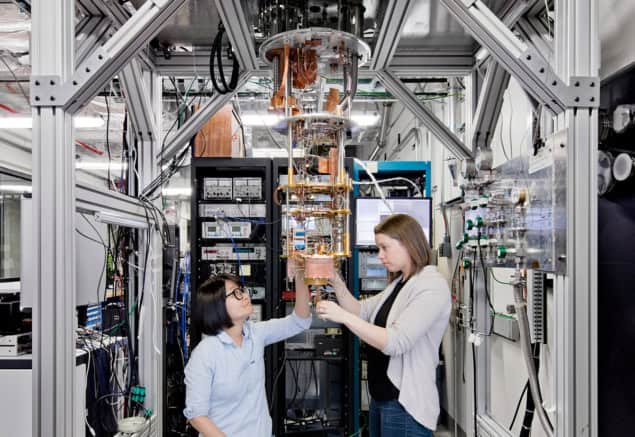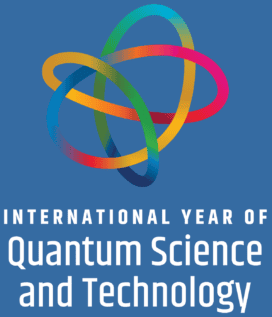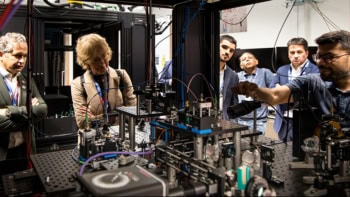Part of our International Year of Quantum Science and Technology coverage
Sarah Sheldon, an engineering physicist from IBM, talks to Joe McEntee about the company’s efforts to open up the next frontier in quantum computing – and why the emerging quantum technology industry is brimming with opportunity for ambitious scientists and engineers

IBM is on a mission to transform quantum computers from applied research endeavour to mainstream commercial opportunity. It wants to go beyond initial demonstrations of “quantum utility”, where these devices outperform classical computers only in a few niche applications, and reach the new frontier of “quantum advantage”. That’ll be where quantum computers routinely deliver significant, practical benefits beyond approximate classical computing methods, calculating solutions that are cheaper, faster and more accurate.
Unlike classical computers, which rely on the binary bits that can be either 0 or 1, quantum computers exploit quantum binary bits (qubits), but as a superposition of 0 and 1 states. This superposition, coupled with quantum entanglement (a correlation of two qubits), enables quantum computers to perform some types of calculation significantly faster than classical machines, such as problems in quantum chemistry and molecular reaction kinetics.
In the vanguard of IBM’s quantum R&D effort is Sarah Sheldon, a principal research scientist and senior manager of quantum theory and capabilities at the IBM Thomas J Watson Research Center in Yorktown Heights, New York. After a double-major undergraduate degree in physics and nuclear science and engineering at Massachusetts Institute of Technology (MIT), Sheldon received her PhD from MIT in 2013 – though she did much of her graduate research in nuclear science and engineering as a visiting scholar at the Institute for Quantum Computing (IQC) at the University of Waterloo, Canada.
At IQC, Sheldon was part of a group studying quantum control techniques, manipulating the spin states of nuclei in nuclear-magnetic-resonance (NMR) experiments. “Although we were using different systems to today’s leading quantum platforms, we were applying a lot of the same kinds of control techniques now widely deployed across the quantum tech sector,” Sheldon explains.
“Upon completion of my PhD, I opted instinctively for a move into industry, seeking to apply all that learning in quantum physics into immediate and practical engineering contributions,” she says. “IBM, as one of only a few industry players back then with an experimental group in quantum computing, was the logical next step.”
Physics insights, engineering solutions
Sheldon currently heads a cross-disciplinary team of scientists and engineers developing techniques for handling noise and optimizing performance in novel experimental demonstrations of quantum computers. It’s ambitious work that ties together diverse lines of enquiry spanning everything from quantum theory and algorithm development to error mitigation, error correction and techniques for characterizing quantum devices.
We’re investigating how to extract the optimum performance from current machines online today as well as from future generations of quantum computers.
Sarah Sheldon, IBM
“From algorithms to applications,” says Sheldon, “we’re investigating what can we do with quantum computers: how to extract the optimum performance from current machines online today as well as from future generations of quantum computers – say, five or 10 years down the line.”
A core priority for Sheldon and colleagues is how to manage the environmental noise that plagues current quantum computing systems. Qubits are all too easily disturbed, for example, by their interactions with environmental fluctuations in temperature, electric and magnetic fields, vibrations, stray radiation and even interference between neighbouring qubits.
The ideal solution – a strategy called error correction – involves storing the same information across multiple qubits, such that errors are detected and corrected when one or more of the qubits are impacted by noise. But the problem with these so-called “fault-tolerant” quantum computers is they need millions of qubits, which is impossible to implement in today’s small-scale quantum architectures. (For context, IBM’s latest Quantum Development Roadmap outlines a practical path to error-corrected quantum computers by 2029.)
“Ultimately,” Sheldon notes, “we’re working towards large-scale error-corrected systems, though for now we’re exploiting near-term techniques like error mitigation and other ways of managing noise in these systems.” In practical terms, this means implementing quantum architectures without increasing the number of qubits – essentially, integrating them with classical computers to reduce noise through increasing samples on the quantum computer combined with classical processing.
Strength in diversity
For Sheldon, one big selling point of the quantum tech industry is the opportunity to collaborate with people from a wide range of disciplines. “My team covers a broad-scope R&D canvas,” she says. There are mathematicians and computer scientists, for example, working on complexity theory and novel algorithm development; physicists specializing in quantum simulation and incorporating error suppression techniques; as well as quantum chemists working on simulations of molecular systems.
“Quantum is so interdisciplinary – you are constantly learning something new from your co-workers,” she adds. “I started out specializing in quantum control techniques, before moving onto experimental demonstrations of larger multiqubit systems while working ever more closely with theorists.”

External research collaborations are also mandatory for Sheldon and her colleagues. Front-and-centre is the IBM Quantum Network, which provides engagement opportunities with more than 250 organizations across the “quantum ecosystem”. These range from top-tier labs – such as CERN, the University of Tokyo and the UK’s National Quantum Computing Centre – to quantum technology start-ups like Q-CTRL and Algorithmiq. It also encompasses established industry players aiming to be early-adopting end-users of quantum technologies (among them Bosch, Boeing and HSBC).
“There’s a lot of innovation happening across the quantum community,” says Sheldon, “so external partnerships are incredibly important for IBM’s quantum R&D programme. While we have a deep and diverse skill set in-house, we can’t be the domain experts across every potential use-case for quantum computing.”
Opportunity knocks
Notwithstanding the pace of innovation, there are troubling clouds on the horizon. In particular, there is a shortage of skilled workers in the quantum workforce, with established technology companies and start-ups alike desperate to attract more physical scientists and engineers. The task is to fill not only specialist roles – be it error-correction scientists or quantum-algorithm developers – but more general positions such as test and measurement engineers, data scientists, cryogenic technicians and circuit designers.

Turning a quantum advantage: IBM’s Jay Gambetta on seamlessly integrating quantum and classical computing
Yet Sheldon remains upbeat about addressing the skills gap. “There are just so many opportunities in the quantum sector,” she notes. “The field has changed beyond all recognition since I finished my PhD.” Perhaps the biggest shift has been the dramatic growth of industry engagement and, with it, all sorts of attractive career pathways for graduate scientists and engineers. Those range from firms developing quantum software or hardware to the end-users of quantum technologies in sectors such as pharmaceuticals, finance or healthcare.
“As for the scientific community,” argues Sheldon, “we’re also seeing the outline take shape for a new class of quantum computational scientist. Make no mistake, students able to integrate quantum computing capabilities into their research projects will be at the leading edge of their fields in the coming decades.”
Ultimately, Sheldon concludes, early-career scientists shouldn’t necessarily over-think things regarding that near-term professional pathway. “Keep it simple and work with people you like on projects that are going to interest you – whether quantum or otherwise.”
This article forms part of Physics World‘s contribution to the 2025 International Year of Quantum Science and Technology (IYQ), which aims to raise global awareness of quantum physics and its applications.
Stayed tuned to Physics World and our international partners throughout the year for more coverage of the IYQ.
Find out more on our quantum channel.




